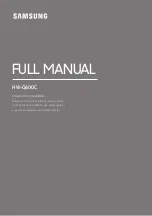
30
Chapter 5 Methods of Wiring Connections for 16 Channels Signal Processor
CI-16-ASP-485 for
Power and Video
Transmission (continue)
Wiring Connections for each channels
1. One end of the Cat5 cable is connected to the RJ45 plug with one pair of the colour coded
Cat.5 wire white/orange and orange connected to Pins 1 and 2 respectively (for
transmission of Power and Video), and another pair of the colour coded Cat.5 wire
white/green and green connected to Pin 3 and Pin 6 respectively (for transmission of Data)
as shown in Fig. 5.3.3, and plugged into the corresponding RJ45 sockets,
③
in Fig.
4.1.1 (on Page 11) of the Signal Processor, as shown at B of Fig. 5.3.1.
(Please note that there is no immediate need for connections to Pin 3 and Pin 6 of the
RJ45 Plug, as there is no Data to be transmitted for the present application. However, to
provide such connections now would make the system readily available for addition
function of Data Transmission when such need arises in future.)
2. At the other end of the same Cat.5 cable, the corresponding pairs of the matched colour
Cat.5 wires for transmission of Power and Video, and Data are similarly connected to a
RJ45 Plug mentioned in paragraph 1 above and plugged into the RJ45 Socket of the
“CC-1RJ Cable Converter for RJ45”, which is then plugged into the Push-Fit Mixer as
shown at A of Fig. 5.3.1, in Fig. 5.3.2 and in Fig. 5.3.4.
3.
A short length of bell cable is connected between the “DC Power to Camera” Push-Fit
Terminals of the Push-Fit Mixer and the Camera, while a short length of suitable cable is
connected between the BNC Plug of the Push-Fit Mixer and the Camera as shown at A
of Fig. 5.3.1 and in Fig. 5.3.2.
Wiring Connection for other channels:
4. The wirings for other 15 channels are connected similarly as described in paragraph 1 to
3 above.
Description of the Power Supply and Transmission of Video Signals:
5. With the wiring connections described above, the Power Supply is provided from the
Built-in Power pack in the Signal Processor through the Cat.5 wire via the Cable
Converter and Mixer to the Camera. The Video Signals are transmitted from the Camera
via the Mixer and Cable Converter through the same pair of Cat.5 wires to the Signal
Processor, and then through the corresponding Video Outlet – BNC Plugs,
⑥
in Fig.
4.1.3 (on Page 12) for further connection to the DVR/Monitor as shown in Fig. 5.3.1.
















































